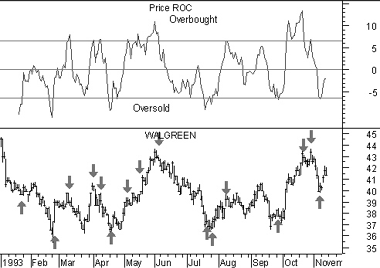|
PRICE RATE-OF-CHANGE
Overview
The Price Rate-of-Change ("ROC") indicator displays the difference between the current
price and the price x-time periods ago. The difference can be displayed in either points
or as a percentage. The Momentum indicator displays the same
information, but expresses it as a ratio.
Interpretation
It is a well recognized phenomenon that security prices surge ahead and retract in a
cyclical wave-like motion. This cyclical action is the result of the changing expectations
as bulls and bears struggle to control prices.
The ROC displays the wave-like motion in an oscillator format by measuring the amount
that prices have changed over a given time period. As prices increase, the ROC rises; as
prices fall, the ROC falls. The greater the change in prices, the greater the change in
the ROC.
The time period used to calculate the ROC may range from 1-day (which results in a
volatile chart showing the daily price change) to 200-days (or longer). The most popular
time periods are the 12- and 25-day ROC for short to intermediate-term trading. These time
periods were popularized by Gerald Appel and Fred Hitschler in their book,
Stock Market Trading Systems.
The 12-day ROC is an excellent short- to intermediate-term overbought/oversold
indicator. The higher the ROC, the more overbought the security; the lower the ROC, the
more likely a rally. However, as with all overbought/over-sold indicators, it is prudent
to wait for the market to begin to correct (i.e., turn up or down) before placing your
trade. A market that appears overbought may remain overbought for some time. In fact,
extremely overbought/oversold readings usually imply a continuation of the current
trend.
The 12-day ROC tends to be very cyclical, oscillating back and forth in a fairly regular
cycle. Often, price changes can be anticipated by studying the previous cycles of the ROC
and relating the previous cycles to the current market.
Example
The following chart shows the 12-day ROC
of Walgreen expressed in percent.
 I drew "buy" arrows each time the ROC fell below, and
then rose above, the oversold level of -6.5. I drew "sell" arrows each time the ROC rose
above, and then fell below, the overbought level of +6.5.
I drew "buy" arrows each time the ROC fell below, and
then rose above, the oversold level of -6.5. I drew "sell" arrows each time the ROC rose
above, and then fell below, the overbought level of +6.5.
The optimum overbought/oversold levels (e.g., ±6.5) vary depending on the security being
analyzed and overall market conditions. I selected ±6.5 by drawing a horizontal line on
the chart that isolated previous "extreme" levels of Walgreen's 12-day ROC.
Calculation
When the Rate-of-Change displays the price change in points, it subtracts the price x-time
periods ago from today's price:

When the Rate-of-Change displays the price change as a percentage, it divides the price
change by price x-time period's ago:

|

